
Ne vous est-il jamais arrivé de sentir qu’il y a plus que ce que vous connaissez sur un sujet ? Que justement vous n’avez exploré que la surface de l’iceberg ? Qu’en creusant un petit peu vous pourriez y trouver une richesse et de nouvelles perspectives ? Eh bien c’est la sensation que j’ai eue avec le framework Cynefin de Dave Snowden. En effet, il me paraît aujourd’hui impensable d’introduire les concepts de l’agilité sans introduire la notion de complexité que ce soit pour la pratique des équipes ou pour l’accompagnement, le coaching.
J’ai souvent fait le choix de parler de la Matrice de Stacey qui me semblait plus évidente à expliquer, mais j’apprécie de plus en plus l’apport du framework Cynefin sur la prise de décision et les modes de leadership associés. Je me suis alors lancé dans son exploration (non sans embûches !) et vous partage dans cette série d’articles, entre la traduction et la restructuration d’informations, ce que j’en ai humblement retenu. 😉
Les autres articles de la série :
L’auteur : Dave Snowden
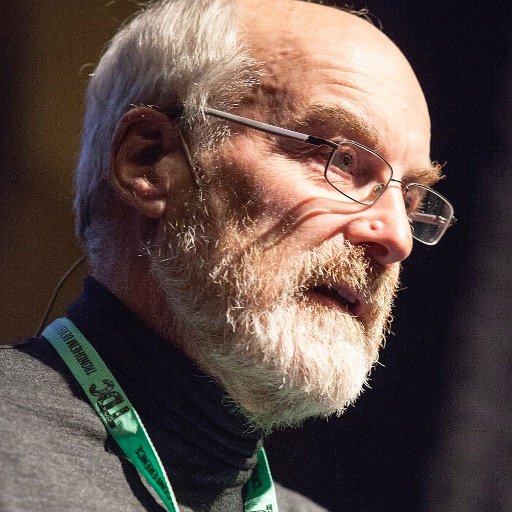
Dave Snowden est un académicien, consultant et chercheur Gallois (ceux qui l’ont rencontré s’en souviennent ! :-P) dans le domaine de la gestion des connaissances. Sa formation initiale est une combinaison de physique et de philosophie ce qui lui a permis d’avoir un regard sur les sciences sociales sous différentes perspectives.
Il est fondateur et Chief Scientific Officer de Cognitive Edge, une société de conseil et un réseau de recherche qui oeuvre pour donner du sens à la théorie de la complexité pour passer à l’action.
Il a développé le framework Cynefin, une application pratique de la théorie de la complexité à la science du management.
Il se décrit souvent comme un « irritant constructif » dans le sens où il va avoir tendance à pousser certains propos à l’extrême pour faire passer ses idées. En effet, selon lui, le danger réside dans le fait que lorsque l’on entend quelque chose avec un langage familier, on risque de l’associer avec ce que l’on connaît alors que c’est une notion totalement différente. Il n’est d’ailleurs pas rare de voir des personnes utiliser de nouveaux termes et de les appliquer aux méthodes qu’ils utilisent déjà depuis déjà 10 ans !
Ces conférences sont teintées d’humour, d’exemples concrets et de termes scientifiques ce qui rend son contenu très riche.
Le framework Cynefin
Origine du nom

Tout d’abord, Cynefin est un mot d’origine galloise qui se prononce “ku-ne-vine”. Sa traduction littérale est « Habitat » ou « Lieu » mais il signifie plus précisément « le lieu aux multiples appartenances ».
C’est la sensation d’être profondément influencé par nos racines (culturelle, religieuse, géographique, tribale) et par d’autres multiples facteurs dont on ne peut qu’être partiellement conscient : un nom donc plutôt bien choisi pour un modèle de complexité.
Vocabulaire
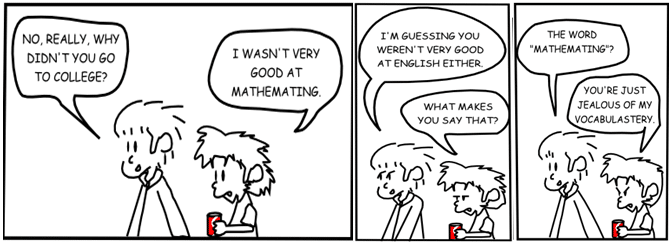
Avant de nous lancer dans la découverte du Framework, mettons-nous d’accord sur le sens de quelques mots employés.
- Système : tout réseau avec cohérence
Il existe un sens dans les écarts entre les choses, pas dans les choses elles-mêmes.
– Alicia Juarrero
Ce sont donc les interactions entre les personnes qui comptent, pas les personnes. Il y a donc un shift conceptuel important car on a tendance à se focaliser sur le changement des individus plutôt que de changer la manière dont ils interagissent entre-eux . Cette approche est en effet plus efficace : essayer de changer chaque personne est trop difficile, le fait de changer les systèmes dans lesquels elles travaillent leur permet de changer plus rapidement.
Ainsi se focaliser sur les concepts de réseaux et de cohérence est une des grandes nouveautés : c’est apprendre à gérer ces écarts vagues entre les choses.
- Agent : tout ce qui agit dans ou sur le système
Il est important de réaliser que les agents dans les sytèmes humains sont rarements des individus. Ce sont généralement des groupes cohérents de personnes, d’intérêts, de mythes ou d’histoires communes. Il est d’ailleurs intéressant de savoir que les mythes ont bien plus d’impacts en tant qu’agents dans les systèmes humains que les personnes.
En effet, il n’y a pas de différence génétique entre nous. La différence vient des patterns engrainés dans les histoires des sociétés dans lesquelles nous avons grandi. On ne peut échapper aux histoires du groupe dans lequel on est. D’après une étude effectuée sur le mapping de culture en entreprises, il suffit de 2 à 3 mois pour un nouvel arrivant dans une entreprise à forte culture pour pouvoir raconter des histoires similaires à celles des personnes présentes depuis une vingtaine d’années. Nous sommes des créatures basées sur le narratif et nous aimons nous conformer.
Description du framework
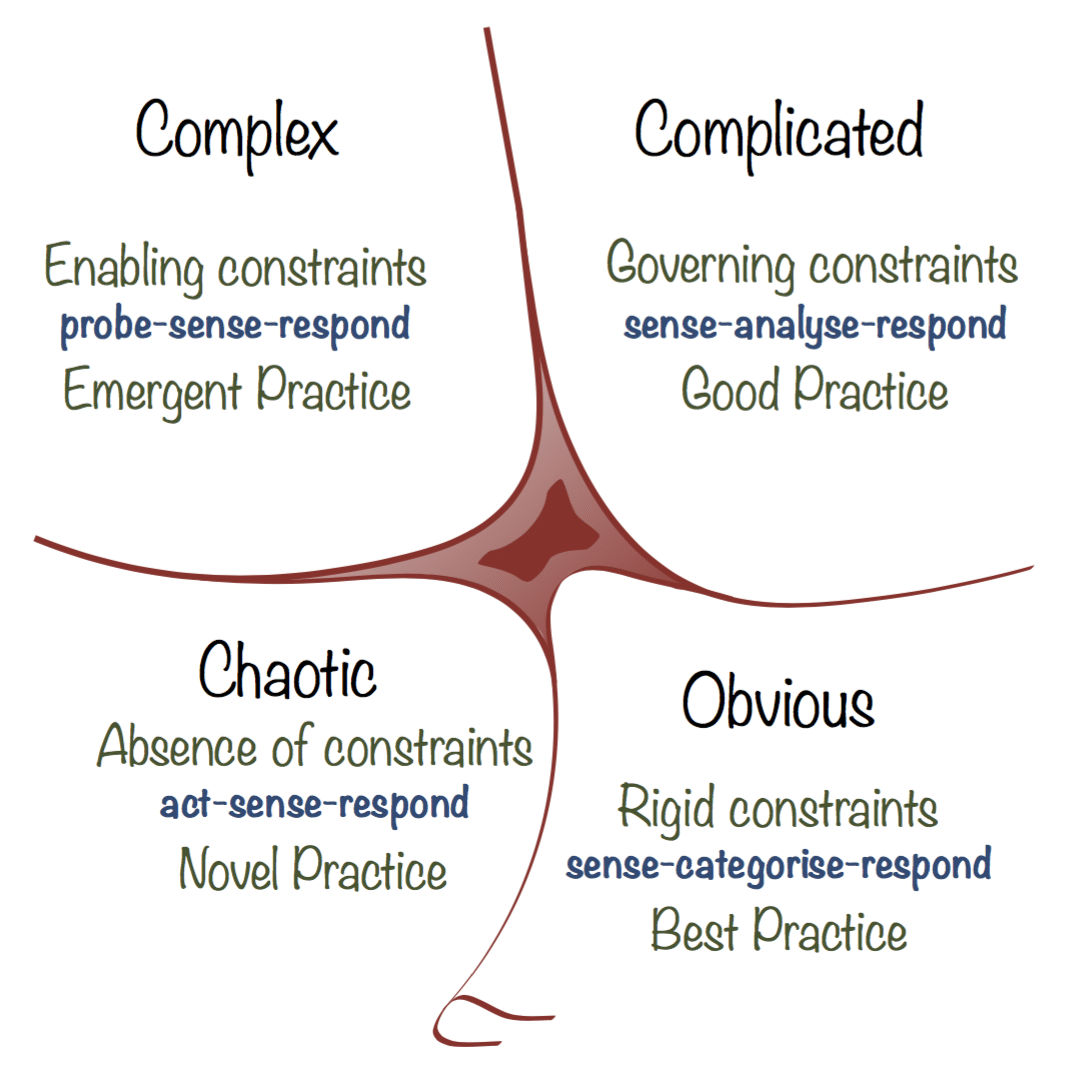
Malgré son apparence, le framework Cynefin n’est pas un modèle de catégorisation sous la forme d’une matrice 2×2 mais plutôt un modèle « créateur de sens » (Sense Making) – ou comme le dirait Dave Snowden, « comment faire sens du monde de manière à pouvoir agir à l’intérieur« .
La différence repose dans le fait que pour un modèle de catégorisation, le framework précède les données alors que pour un modèle de Sense Making c’est l’inverse : les patterns ou le framework lui-même émerge des données.
La catégorisation a néanmoins ses avantages : elle est rapide. Il suffit de déposer les données dans les bonnes cases et de décider en fonction. Le danger est que l’on risque d’être pris au dépourvu car on ne voit les différences les plus subtiles que trop tard. La catégorisation est bonne pour l’exploitation de données mais pas pour leur exploration au rythme du changement.
Le framework se construit en partant du fait qu’il existe 3 types de systèmes dans la nature : les systèmes ordonnés, complexes et chaotiques.
On divise alors les systèmes ordonnés en évident et compliqué – la raison pour cela est une question de perception des personnes, ce qui a une importance. On y ajoute ensuite une nouvelle catégorie que l’on appelle Désordre.
Une chose importante à garder à l’esprit est qu’il n’y a pas de meilleur système, ils sont tous contextuellement appropriés. Chacun possède alors des caractéristiques (type de contraintes, modèle de décision, typologie de pratiques) qu’il est important de comprendre pour pouvoir mieux agir.
Système ordonné
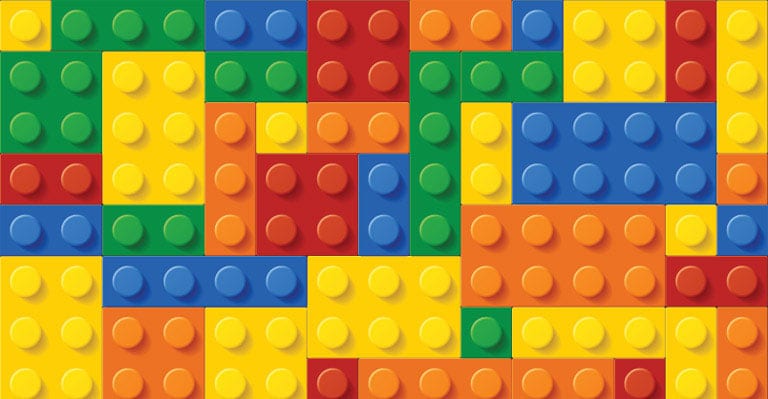
Un système ordonné est un système ayant un niveau de contraintes très élevé. Il n’y a pas de degrés de liberté donc le comportement des agents est totalement contrôlé et prédictible. Ceci est unique aux humains et nous sommes plutôt bons là dedans. En effet, il est important de comprendre que tout ce qui implique l’humain n’est pas forcément « complexe » car avec l’intelligence, nous pouvons et nous savons mettre des contrôles de processus en place imposant l’ordre – et c’est une bonne chose ! Le problème est que nous poussons la chose à l’excès. On commence à désirer l’ordre indépendamment de l’utilité.
Maintenant, si l’on impose un niveau excessif de contraintes que le système ne supporte pas, les choses vont aller sous terre. Dans ses années chez IBM, Dave et ses collègues ont découvert qu’il y avait une correlation directe entre le niveau perçu de bureaucratie d’une organisation et la densité des réseaux informels. La raison est simple : plus le niveau de bureaucratie est élevé, plus il faut connaître de monde (ou tout du moins les bonnes personnes) pour faire que les choses avancent !
Le problème dans ce type de système est que les personnes utilisent ce mécanisme de survie pour cacher les défaillances du système : en tant qu’être humain, nous n’aimons pas que les choses aillent mal (ce qui est tout à notre honneur) ce qui fait que nous nous efforçons de faire fonctionner le système malgré des règles qui nous en empêchent. Le danger est que lorsque la défaillance fait surface, c’est une véritable catastrophe car la tension dans le système s’est accumulée et on obtient un changement disruptif massif.
L’ordre a de la valeur tant que le système a la capacité de le supporter, sinon il est dangereux.
-
Système Évident : le domaine des Best Practices

Un système simple est un système ordonné, ce qui signifie que la relation entre cause et effet existe, est prédictible, et peut être déterminée à l’avance.
La relation étant évidente, le modèle de décision correspondant est : sentir – catégoriser – répondre. On voit ce qui arrive, on le fait rentrer dans des catégories et on décide quoi faire selon les pratiques établies.
On peut alors appliquer des Best Practices car tout le monde s’est accordé à faire les choses d’une certaine manière. On a donc des contraintes rigides.
-
Système Compliqué : le domaine des Experts
Système compliqué – construire un avion
Dans un système compliqué, il existe une relation entre cause et effet mais elle n’est pas évidente.
On peut alors faire appel à un expert et déployer une méthode analytique du type sentir – analyser – répondre. Il est alors possible de définir une approche répétable, durable et scalable qui produira toujours le même résultat.
On n’applique alors pas de Best Practices, mais des Good Practices. Cette distinction de terminologie peut paraître anodine mais elle est en fait particulièrement importante. En effet, dans le domaine du compliqué, il y a de multiples façons de faire les choses – toutes légitimes si l’on a la bonne expertise d’où le fait que l’on a des contraintes d’applicabilité (plutôt que des contraintes rigides) permettant la variabilité des solutions dans le schéma.
Système Complexe : le domaine de l’Emergence

Un système complexe est un système sans causalité. C’est un système dans lequel les contraintes et les agents co-évoluent. Les contraintes sont flexibles et négociables, on peut parler de co-évolution. Lorsque des patterns se forment, ils se stabilisent mais on ne peut quoi qu’il arrive pas revenir en arrière. On travaille donc toujours de la stabilité ou de l’instabilité courante.
Dave Snowden évoque la métaphore d’une table ronde autour de laquelle se trouvent des électroaimants et au milieu des roulements à billes en fer. Si l’on change un des aimants, le pattern de changement du roulement à bille évolue de manière prédictible et répétable. En systémique, l’aimant s’appelle le « pilote » (driver). C’est d’ailleurs ce que tout le monde veut connaître : le comportement du driver. Dans un système adaptatif complexe, il y a beaucoup d’aimants et en fait ils changent tous en même temps. Alors vous allez changer cet aimant cette fois-ci et cela va produire cet effet, la prochaine fois que vous le ferez, cela produira un effet totalement différent. En théorie de la complexité, les aimants sont appelés « modulateurs » (modulators).
Un système complexe adaptatif est donc « modulé » et non « piloté ». Les petites choses produisent des effets radicalement différents, on n’obtient pas de répétabilité : un système adaptatif complexe n’est pas causal au sens conventionnel du terme mais dispositionnel. Si un événement se reproduit, c’est par accident mais on peut mesurer les dispositions du système à évoluer dans différentes directions.
Dans un système complexe, on expérimente avec des contraintes pour voir ce qui est durable. On n’impose pas de contraintes tant que l’on ne sait pas si elle est valable. Un aspect primordial est que l’on passe de la conception sécurisée à de multiples expérimentations Safe-to-Fail.
Le modèle de décision est ici du type sonder – sentir – répondre.
Si une expérience réussit, on l’amplifie. Si une expérience commence à échouer, on l’atténue. Une expérience ne devrait être réalisée que si l’on a identifié des stratégies d’amplification ou d’atténuation à l’avance.
On obtient alors ici un ordre émergent, quelque chose qui provient d’une pratique émergente, nouvelle. Elle peut être le fruit d’une combinaison mais n’en reste pas moins différente et unique.
Système Chaotique : le domaine de la réponse rapide

Dans un système chaotique, il n’y a pas de contraintes. Les relations entre causes et effets sont donc impossibles à déterminer car elles changent constamment et aucun patterns manoeuvrables n’existent – seulement de la turbulence. C’est le domaine de l’inconnaissable et chaque agent est indépendant des autres. Ce dernier élément peut avoir une grande valeur pour le concept de sagesse des foules par exemple qui stipule que l’agrégation de l’information dans les groupes, résultant en évaluations, seront souvent meilleures non seulement que celles d’individus isolés du groupe, mais que la moyenne des évaluations du groupe (la différence provenant d’une prise en compte de l’information de diversité d’où l’importance de l’indépendance).
2 cas de figure se distinguent alors :
- si on y entre délibérément c’est pour l’innovation
- si on y entre par accident alors on a besoin de stabiliser une position rapidement.
Le modèle de décision est ici du type agir – sentir – répondre. On bouge ainsi très rapidement pour stabiliser la situation.
Toute pratique sera complètement nouvelle au vu du fonctionnement actuel.
Note : ce système est très difficile à soutenir car l’effort est énorme pour garder les éléments indépendants.
Désordre

L’espace central correspond au désordre. C’est un espace clé (inexistant à ma connaissance dans la Matrice de Stacey) où l’on est lorsqu’on ne sait pas dans quel domaine on se situe. Et c’est là que l’on est la plupart du temps. La difficulté est alors que l’on a tendance à interpréter la situation selon la manière dont on préfère personnellement agir.
- Simple : si l’on a passé un certain temps de notre vie dans un environnement purement bureaucratique, le danger est que l’on va avoir tendance à voir tout problème comme étant un échec de processus.
- Compliqué : en tant qu’expert, tout problème est dû à un manque de temps ou de ressources pour effectuer une analyse.
- Complexe : les politiciens sont naturellement des personnes travaillant dans la complexité. Leur réaction en situation de crise est de rassembler un grand nombre de personnes de profils et d’antécédents différents avec l’espoir désespéré que quelqu’un trouvera la bonne solution ce qui est finalement une assez bonne stratégie.
- Chaotique : le levier fasciste dans une situation de crise est d’obtenir le commandement absolu pour que chacun fasse ce qu’on lui dit de faire.
Ainsi ce que l’on obtient dans le cadre d’un environnement de décision normal est que les personnes sont dans un espace désordonné, évaluant la situation selon leur mode d’action préféré.
La frontière entre le simple et le chaotique
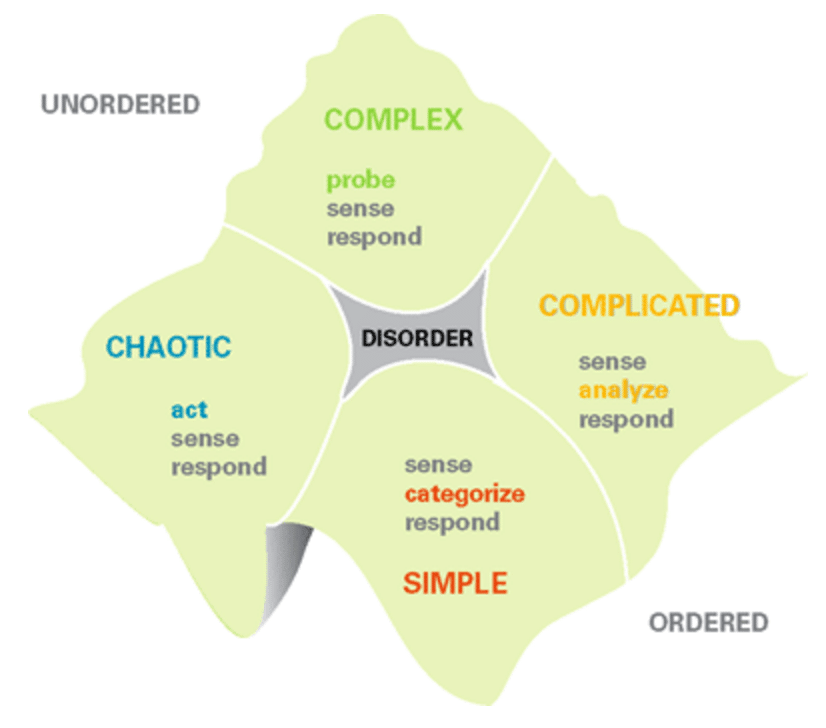
Un aspect souvent oublié par les personnes tentant de trop simplifier le framework Cynefin est la frontière entre les systèmes simples et chaotiques qui s’avère être différente des autres. En effet, elle est représentée sous forme de falaise dans l’article initial paru dans Harvard Business Review, ou sous forme d’une vague symbolique dans d’autres articles.
Le principe est ici que si l’on commence à croire que les choses sont simples, on commence à croire qu’elles sont ordonnées, on commence à croire en nos propres mythes, on commence à croire que nos réussites passées nous rendent invulnérables à des échecs futurs. On se déplace alors effectivement vers la zone de complaisance qui est la frontière entre le simple et le chaotique jusqu’au moment où l’on tombe dans le vide, directement dans une crise.
Toutes les autres frontières permettent des transitions, pour celle-ci on tombe dans le vide et le rétablissement est très très coûteux.
On devrait alors manager dans les espaces compliqués et complexes et ne déplacer qu’une infime quantité d’éléments dans le simple car très peu vulnérables aux changements rapides.
L’exemple de la fête pour enfants

Voici la métaphore prise par Dave Snowden à de multiples reprises pour illustrer les différents types de systèmes.
Imaginez que vous souhaitiez appliquer les différents types de systèmes qui existent dans la nature à l’organisation d’une fête pour des enfants d’une dizaine d’années :
Environnement chaotique
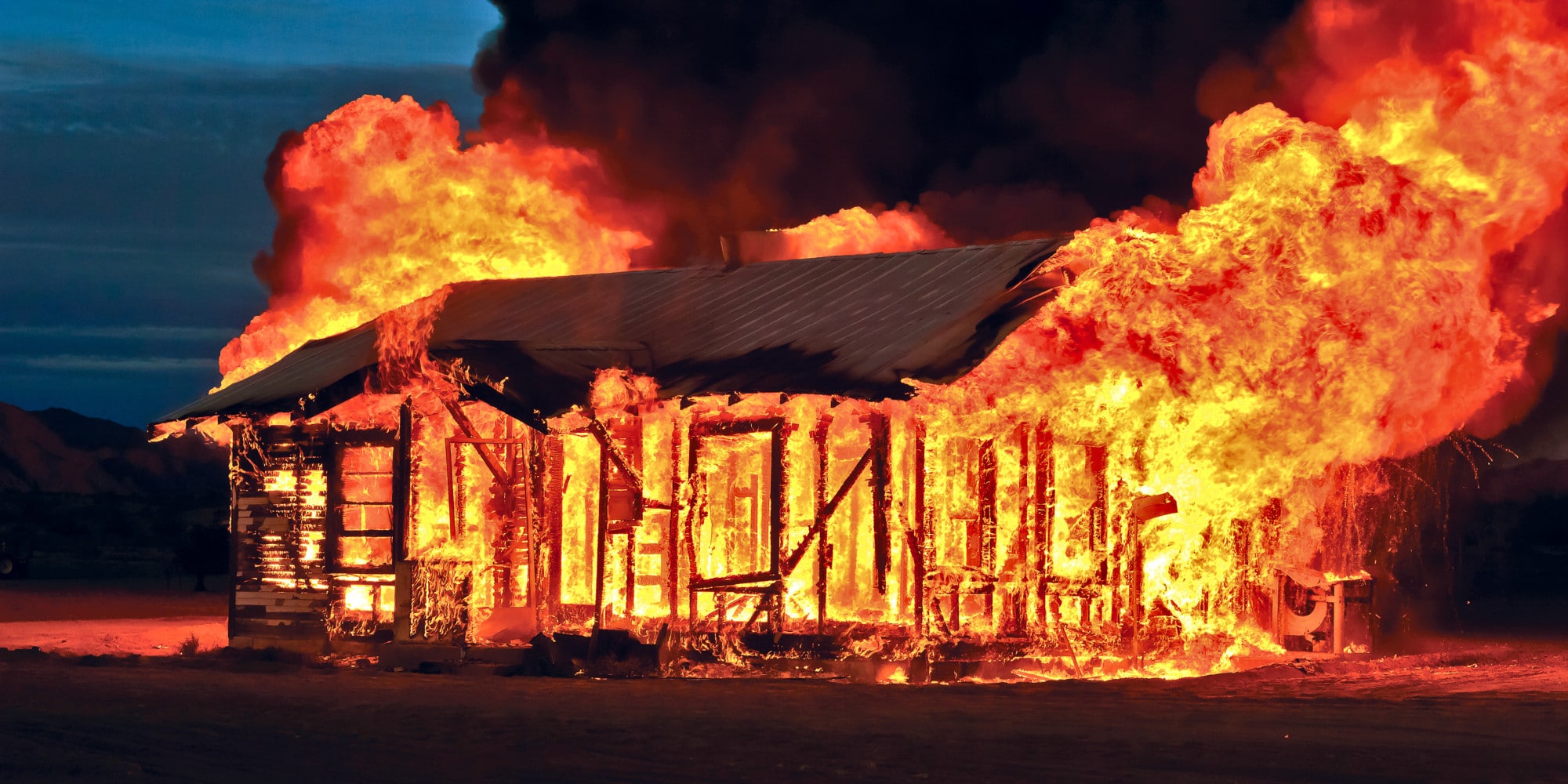
Si l’on suppose que la fête est chaotique, les enfants agissent aléatoirement. Ils pourraient même être en train d’entreprendre une expérience personnelle de découverte d’eux-mêmes à l’aide de drogues et d’alcool et votre maison pourrait d’ailleurs brûler dans le processus. J’ai des amis en Californie qui ont essayé mais jamais plus d’une fois, le coût de rétablissement étant particulièrement élevé.
Environnement ordonné

Ici, il est d’une importance critique de construire des objectives d’apprentissages clairement articulés à l’avance. Ces derniers devront bien sûr être alignés avec l’énoncé de mission pour l’éducation dans la société à laquelle vous appartenez. Idéalement, vous pourriez imprimer ces objectifs d’apprentissages sur des posters de motivation avec des images d’aigles s’élevant dans la vallée ou d’eau tombant dans des lacs et les placer dans la salle où se tiendra la fête.
Vous produisez ensuite un planning de projet pour la fête. Ce planning de projet devra comporter des jalons clairs tout au long de la fête dont vous pourrez mesurer l’avancée, en les comparant aux résultats de fête idéaux.
Une fois que cela est fait, les adultes séniors peuvent démarrer la fête avec une vidéo de motivation (après tout vous ne voulez pas que les enfants perdent leur temps à jouer – ce qui n’est pas aligné avec les objectifs d’apprentissage de la fête elle-même) et devraient utiliser des powerpoint pour prouver leur engagement personnel aux objectifs de la fête et montrer aux enfants comment leur argent de poche est lié à la réussite des objectifs fixés.
Après la complétion très réussie de la fête, vous conduisez une revue des actions futures, vous mettez à jour votre base de données sur les best practices de gestion de fête et mandatez de futures améliorations de processus.
Environnement complexe
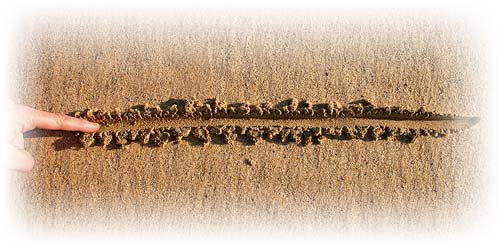
L’approche complexe est encore plus simple. On l’appelle d’ailleurs parfois « la nouvelle simplicité ». Ici, on trace une ligne sur le sable (connue sous le nom de frontière / limite en théorie de la complexité), on se tourne vers les enfants et on leur dit :
« Dépassez cette ligne bande de petits ******* et vous mourrez »
Une chose que l’on apprend rapidement en tant qu’adulte est la valeur de limites flexibles et négotiables. En effet, les limites rigides ont l’habitude de devenir fragiles et de se briser de manière catastrophique. On utilise alors des sondes catalytiques (football, vidéo, barbecue, jeux vidéos), quelque chose qui va stimuler un pattern d’activité que l’on appelle un attracteur. Si c’est un attracteur bénéfique, on le stabilise et on l’amplifie, si c’est un attracteur négatif, on l’atténue ou on le détruit très rapidement.
Le principe fondamental de la théorie de la complexité appliqué aux organisations ou au développement logiciel est donc de :
Gérer l’émergence d’une cohérence bénéfique au sein d’attracteurs, à l’intérieur de limites.
On gère la conditions des limites, on gère les sondes, on gère l’émergence de cohérence bénéfique. C’est un processus évolutionnaire qui prend beaucoup moins de ressources que l’approche ordonnée, mais qui produit plus de résultats bénéfiques malgré le fait qu’ils ne puissent être prévus à l’avance.
Dynamiques et cadences Cynefin
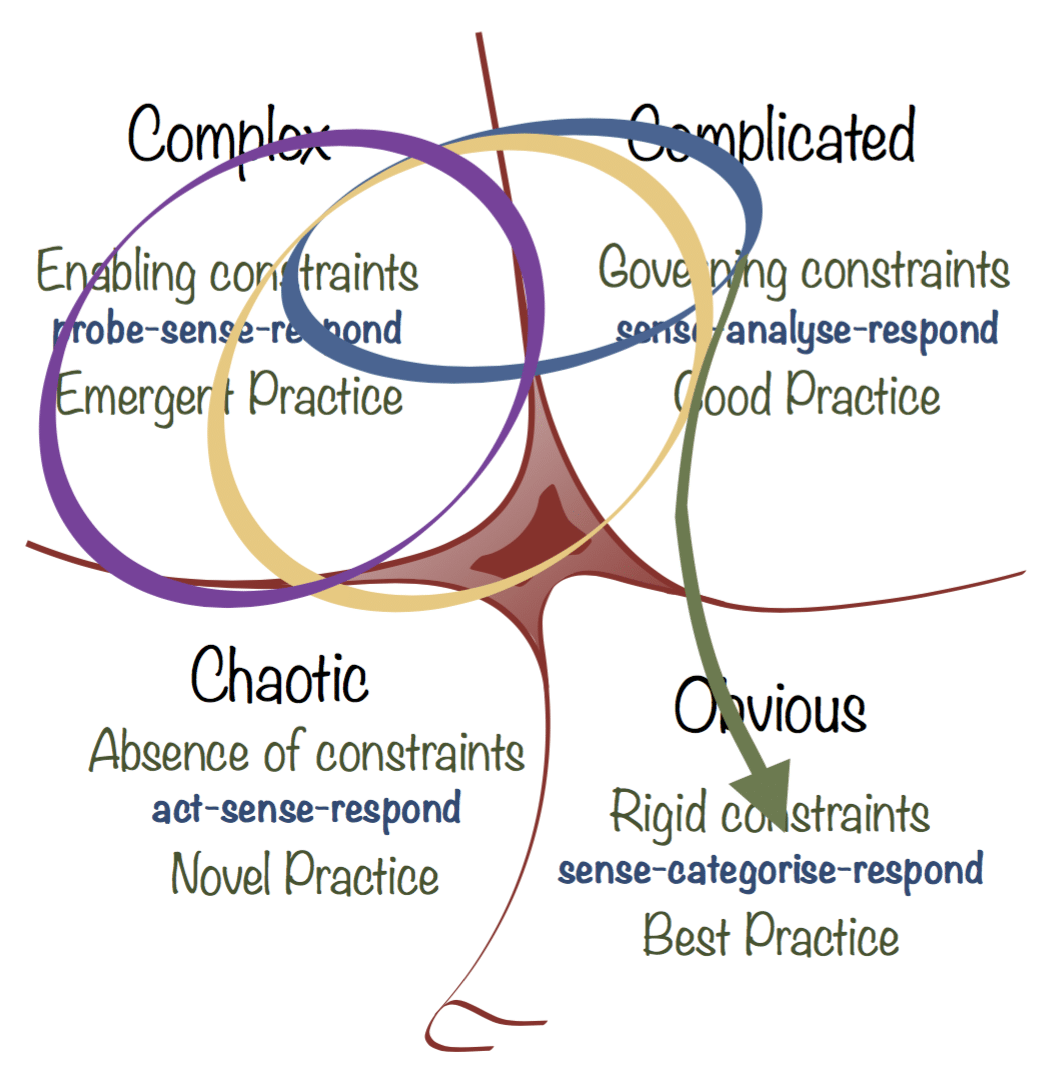
Mettre les méthodes (Scrum, Kanban…) dans des boites est une mauvaise idée. La plupart d’entre-elles sont plutôt des mécanismes de transition entre les domaines et non pas à l’intérieur des domaines; et elles ont de la valeur de ce fait.
Scrum est une méthode de transition très efficace entre le complexe et le compliqué.
Ce qu’il faut garder de Cynefin est qu’il est en fait question de dynamiques, de cadences.
Le niveau stratégique (en bleu)
C’est ce que l’on veut véritablement réussir au niveau stratégique. Lorsqu’un pattern émerge et devient visible dans le domaine complexe (exploration), on augmente les contraintes de manière à pouvoir l’étudier (exploitation). On relâche les contraintes de manière à ce que de nouveaux patterns deviennent évidents. C’est donc un mécanisme où l’on teste les contraintes pour la répétabilité. C’est une cadence naturelle dans laquelle il faut se donner la possibilité de pouvoir revenir dans l’état de stabilité précédent.
La remise à zéro (en jaune)
Sinon on rentre dans ce que l’on appelle la « légère plongée dans le chaos ». On n’effectue jamais de plongée profonde car les personnes risquent de ne pas s’en remettre. Ce l’on fait alors est que l’on se débarasse des contraintes pendant un temps très court pour que de nouveaux patterns puissent émerger . Cette dynamique est généralement utilisée lors de majeures remises à zéro.
Ce qui ne changera pas (en vert)
Une petite quantité d’éléments vont dans le domaine de l’évident. Ces éléments se déplacent là pour mourir : attention, ces éléments peuvent mettre une vingtaine d’années à mourir et constituer 60 % de votre business. Ce n’est donc pas qu’ils ne sont pas importants, mais plutôt qu’ils ne vont pas avoir besoin d’être changés. Lorsque les choses n’ont pas besoin de changer, on les codifie et on les rend rigides.
Note : le seul endroit où les méthodes structurées fonctionnent est lorsque l’on commence dans le compliqué et que l’on va dans l’évident. Tout le reste produit des comportements non authentiques donc cela ne marchera pas (ou alors par accident).
La dynamique de pâturage (en violet)
C’est un cas où le rythme du changement ne nous permet pas de stabiliser et que nous avons besoin de maintenir des approches d’expérimentations constantes ce qui a de grandes implications pour l’architecture et la modularisation.
Conclusion
Voici la fin de ce premier article centré sur le Framework Cynefin et ses caractéristiques.
Le second article portera sur les changements de modèles liés aux apports de la théorie de la complexité et des systèmes complexes adaptatifs.
Références
- Dave Snowden : https://en.wikipedia.org/wiki/Dave_Snowden
- HBR Article : https://hbr.org/2007/11/a-leaders-framework-for-decision-making
- Cognitive Edge : http://cognitive-edge.com/
- The Cynefin Framework : https://www.youtube.com/watch?v=N7oz366X0-8
- How to organize a children party : https://www.youtube.com/watch?v=Miwb92eZaJg
- Making Sense of complexity : https://www.youtube.com/watch?v=y6RfqmTZejU
- Simple but not simplistic : https://www.infoq.com/fr/presentations/scrumday-dave-snowden-simple-but-not-simplistic
- Un excellent article de SOAT : http://blog.soat.fr/2014/01/le-framework-cynefin-et-la-gestion-des-connaissances/
- Sagesse des foules : https://fr.wikipedia.org/wiki/La_Sagesse_des_foules
- Strategic Understanding with Prof. Dave Snowden : https://www.youtube.com/watch?v=PFi9mIlp2NY
- Think anew, Act anew : https://www.youtube.com/watch?v=s8SayvnfQi0








8 réponses
Merci pour cet excellent article, tout y est! Je me suis permise de faire un lien vers votre article ici : https://www.in-imago.com/blog/outils-pour-un-m…tegique-efficace/
Merci pour cet excellent article. Tout y est! Je me suis permise de mettre le lien vers votre article dans le mien :https://www.in-imago.com/blog/outils-pour-un-management-strategique-efficace/.
Merci pour votre article.
Il y a cependant un point qui me questionne. C’est la différence qui y est faite entre le ‘compliqué’ et le ‘complexe’ i.e. ‘complexe’ peut aussi se définir comme le contraire de ‘simplex’. C’est la notion du ‘tout’ constitué de ses parties. Notion essentielle en ingénierie système pour l’analyse des problèmes quand un problème(/système) ‘complexe’ est décomposé en sous-problèmes(/sous-systèmes) ‘compliqués’ afin d’en appréhender la complexité. Qu’en pensez-vous ?
Salutations,
Bonjour François,
Merci pour votre message.
Je pense que dans tous les domaines, il existe une terminologie qui nous permet de lui donner sens et de l’utiliser dans notre contexte. Et souvent malheureusement, les mêmes mots n’ont pas le même sens (ce serait trop facile sinon !)
N’étant pas assez familier du domaine de l’ingénierie « système », la seule chose que je peux dire est que de par la manière dont vous l’avez décrit, cela rentre bien dans ce que l’on met derrière le domaine « Compliqué » de Cynefin. En effet, la notion de grand problème décomposable (et donc recomposable) en de sous-problèmes est par définition du ressort du compliqué. D’ailleurs la stratégie associée est bien principalement de l’analyse du problème pour ensuite pouvoir y répondre – qui part du principe qu’une solution de cause à effet existe et qu’il suffit de la rechercher.
Dans le domaine « Complexe », typiquement un système humain, amènerait à avoir une démarche plus empirique : une définition d’un cadre d’étude avec des résultats attendus et une conclusion à posteriori.
Les postulats initiaux et la stratégie associée est donc légèrement différente selon ce que l’on met dans un domaine ou un autre, cependant cela est souvent relatif à la perception de chacun sur l’appartenance de tel ou tel sujet à tel ou tel domaine.
Belle journée !
Olivier
En fait la distinction complex/complicated vient du bouquin de Cilliers Complexity and Postmodernism. Un avion c’est compliqué: plein de parties et de relations dures a appréhender mais il est possible de les connaitre et de les prévoir (l’avion ne change aps de comportement quand il voit le reparateur arriver) et donc d’etre expert en avion sinon on montrait pas dedans. Une société c’est evolutionnaire, quand tu parles de restructuration dans le hall y’a deja des agents qui ont changé de comportement donc c’est insaisissable et on peut pas être expert mais jsute lancer des safe to fails probes.
Merci Olivier pour votre réponse
Sur la notion d’Ordre, désordre et émergence il y a aussi cet article https://philosciences.com/philosophie-et-societe/17-edgar-morin-complexite.
Bonne journée,